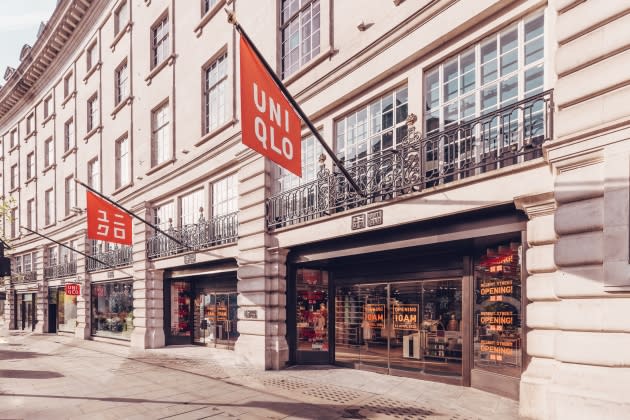Fast Retailing’s Yanai Outlines New Strategy to Boost International Growth

TOKYO — Fast Retailing is taking a glo-cal approach — and strengthening its management team in order to implement it.
As the retailer reported year-end results on Thursday, Fast Retailing’s chairman, president and chief executive officer Tadashi Yanai reiterated his aim to become the world’s number-one brand, and emphasized that international expansion would be key to achieving this. Reforms related to human resources would also be key, he said.
More from WWD
Yanai outlined a new strategy for Fast Retailing that aims to achieve his goal, centered on giving local operations greater control over key decision-making rather than having everything emanating from the Tokyo headquarters.
“We intend to create new organizational frameworks where, instead of having the Tokyo global headquarters make all decisions and direct all operations in other markets, managers in each market, together with those in charge of production, distribution, IT and other functions will make their own decisions and solve issues based on appropriate local frontline information,” Yanai said. “At the same time, managers from global headquarters will travel around the world and visit various on-the-ground operations to assist with management decisions and processes.”
In addition to the company’s Tokyo global headquarters, Yanai said its New York office would be further developed so that it can act as an additional global headquarters. Management reforms include the appointment of Daisuke Tsukagoshi — current head of Uniqlo in the U.S. — as global CEO of Uniqlo, and Takahiro Wakabayashi as Uniqlo’s global chief operating officer.
Yanai said significant changes will also be implemented with the company’s stores, transforming them from places to buy products to places to convey information to customers and serve as a hub for a local community.
“When it comes to offering customers a comfortable purchasing experience through our app and website, nearly all of that can be realized virtually, including online fittings. We are currently in the implementation phase, technologically speaking,” Yanai said. “That being the case, the future significance of our stores will lie in being able to provide something that cannot be done online, namely a physical experience. So we will continue to ensure ultimate convenience for our customers using digital technology, while our stores will be transformed into places that offer customers a polished optimum experience. In short, our stores need to evolve from places that offer things to buy to places that offer the ultimate shopping experience.”
Uniqlo has seen initial success with live commerce initiatives, and Yanai said he plans to continue strengthening these activities in the future.
“In Japan in particular, we aim to progress with bold scrap and build policies of replacing smaller, less profitable stores, with larger, better located ones so that stores can exhibit their individual strengths and features in a more obvious way,” the executive said.
For the year ended Aug. 31, the company’s net profit jumped 60.9 percent to 273.3 billion yen, or $1.85 billion at current exchange rates. It said that profits were at record levels, both before and after accounting for changing foreign exchange rates.
Fast Retailing said operating profit for the period increased by 19.4 percent compared with the previous year, totaling 297.3 billion yen.
The Uniqlo parent’s yearly sales came in at 2.3 trillion yen, representing growth of 7.9 percent over the prior year.
Among the group’s individual business segments, Uniqlo International saw operating profit climb 42.4 percent to 158.3 billion yen, while revenue grew by 20.3 percent to 1.12 billion yen. Both Uniqlo North America and Uniqlo Europe showed strong growth in revenue and saw a return to profitability.
Uniqlo Japan’s operating profit increased slightly, gaining 0.6 percent to total 124 billion yen, while sales decreased by 3.8 percent, coming in at 810.2 billion yen. Same-store sales contracted by 3.3 percent from a year ago, but grew by 4.7 percent in the second half of the year. Yearly e-commerce sales increased by 3.1 percent to 130.9 billion yen, with the share of total revenue continuing a steady expansion to 16.2 percent.
At GU, Fast Retailing’s low-priced, fashion casualwear brand, operating profit fell by 17.4 percent to 16.6 billion yen, while revenue decreased by 1.4 percent from a year ago to 246 billion yen. Manufacturing delays and logistical issues disrupted product launches in the first half of the fiscal year, but revenue increased in the second half with a further tightening of the product range and steps to capture mass fashion trends.
The company’s Global Brands segment reported an operating loss of 700 million yen, compared with a loss of 1.6 billion yen in the previous year. The segment’s total revenue rose 13.8 percent year-on-year to 123.1 billion yen.
Fast Retailing also released its guidance for its current fiscal year, ending Aug. 31, 2023. As this forecast excludes any impact from foreign exchange gains or losses, it predicts a 15.9-percent decline in net profit, for a total of 230 billion yen.
Yearly operating profit is expected to rise by 17.7 percent to 350 billion yen.
The company is predicting sales growth of 15.2 percent, for a total of 2.65 trillion yen.
